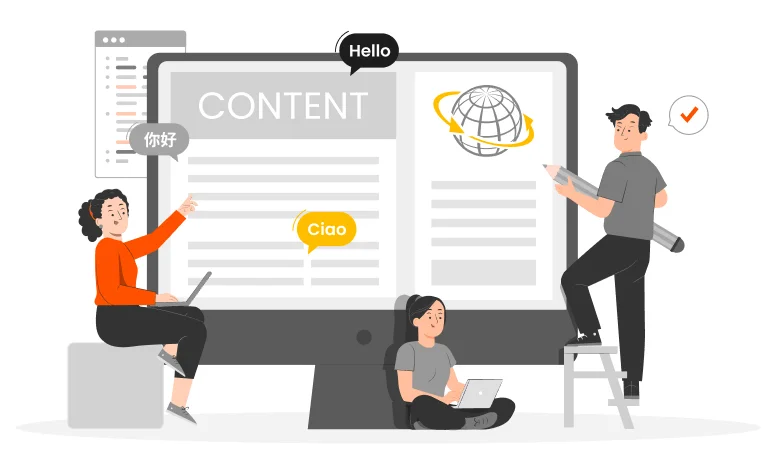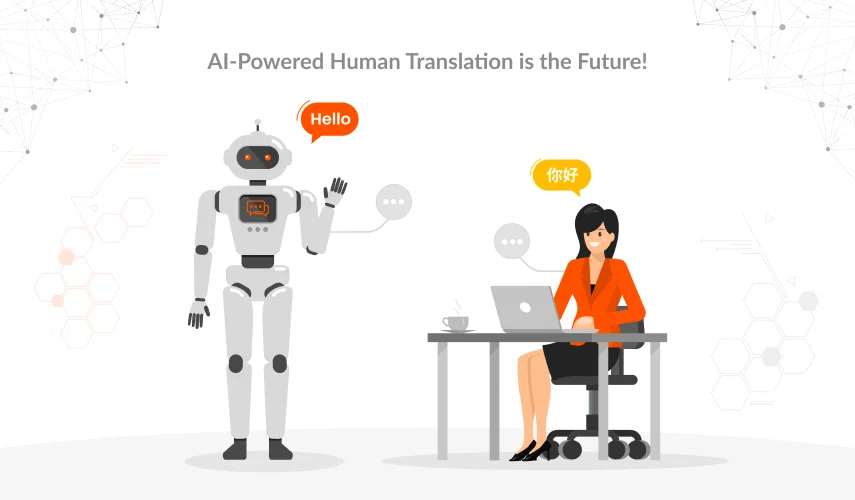The quality of your translation has a huge impact on your company’s reputation in the international market. It is important for brands to generate high-quality translations for their businesses’ content because it is going to have a direct impact on customers. To maintain the quality of translations, companies hire qualified translators, linguists, and editors who would help them meet the quality standards considering all the cultural and linguistic nuances.
If you are a global business or a language service provider who has to manage a massive amount of translation every day, it’s important to focus on generating quality translations. As your business operations grow, you have to manage volumes of translations regularly which can affect the translation quality. Especially, in the case of machine translation, managing the translation quality is even more challenging. In this article, we’ll discuss machine translation and what are the best ways to evaluate machine translation quality.
What is Machine Translation?
In machine translation, an app is used to generate automated translations into multiple languages using AI technology. Compared to human translations, these machine translations produce faster results, at much lower rates. There was a time when machine translations were not a preferable choice because of their error-prone translations. However, things have changed a lot. Machine translation is now a billion-dollar industry with incredible developments. The demand for machine translation is growing to meet the increasing need for creating localized brands that resonate with locales.
With the help of advanced computational linguistics and artificial intelligence, machine translation systems have become smart enough to provide high-quality and error-free translations. Some machine tools are so excellent that you can hardly tell if the translation is done by a machine or a human. Businesses use a combination of machine translation with professional translators to ensure the best quality at the fastest turnaround time.
Why Evaluate Machine Translation Quality?
The machine translation industry is continuously growing with the increasing demand for localized content around the globe. Although machine translation technology has evolved a lot; however, you can’t totally depend on it. It is important to keep a quality check on your translations because, in the end, it is a machine that generates content, and it does have chances of mistakes.
Every translation that your machine generates should go through a quality assessment test. For this purpose, you can use a quality assurance tool, or get some native speakers onboard to check the quality. Professional human translators and linguists can help you correct the errors and finalize the translation documents.
Skilled translators go through the translation files and check the glossaries to ensure that your translations are in context and error-free. Moreover, they also evaluate the style and tone of translations to keep them consistent across all regions.
How To Evaluate Machine Translation Quality?
It has become important for global businesses and LSPs to cope with the growing demand for localized brands. The translation is the main aspect of your brand localization. As your business grows, the need for translation also increases, and to meet that need, you require a solution that is cost-effective and agile at the same time. Quality assessment tasks can be very time-consuming because there are a massive amount of documents translated into multiple languages.
Following are some significant methods that businesses and LSPs use to evaluate their machine translation quality.
Manual Evaluation
This is known to be the most common method to evaluate machine translation. In this method, professional translators and linguists assess and evaluate the translations done by machines. They are mostly native speakers who understand the cultural nuances and linguistic intricacies. Here are a few things that a human translator would evaluate in your translation throughout the proofreading and editing process.
1. Fluency and Clarity
First, human translators would evaluate the fluency in the translation. It has to be smooth with good clarity in the target language. For this purpose, it is important to hire native speakers with good translation backgrounds and fluency in your target language. One important thing to consider is that your translator doesn’t have to access the source text, so there is no need to match the source text with the translations.
2. Accuracy
There is nothing more devastating for your brand than poorly translated content with a lot of errors. Your translations have to be error-free and accurate, so you can build a positive and trustworthy brand in foreign markets. Errors can be linguistic, grammatical, or cultural. To test the accuracy of your translated documents and fix the errors, your translator should be bilingual, so he/she can match the source text with the translated one.
3. Cultural Context
Your translations have to be culturally appropriate. In the end, the purpose of brand localization is to connect with the local audience, which is only possible if your translations are well-blended with the local culture. You must hire a local translator to check the cultural accuracy of the translation and ensure that the message is culturally strong enough to capture the attention of more customers.
4. Tone and Style
In the end, the tone and style of your translations are evaluated. For this, you must provide your professional linguistics with style guides and translation glossaries. It will help to ensure that the tone and style of your translation match the brand voice.
Automated Evaluation
Automated evaluation is done by specialized systems that are designed to detect errors (contextual, and linguistic) and other issues in your translation documents. Quality assurance software uses advanced AI technology and powerful algorithms to detect potential translation errors and calculate your translation quality score accordingly. It considers different factors to test the quality of translation, such as word count, sentence, and contextual errors.
However, the automated evaluation does have some shortcomings, and to get accurate results, you might need to perform an evaluation test multiple times. The automated machine translation evaluation test totally depends on the translation references your evaluation tool has. Moreover, the accuracy rate of this evaluation is not as perfect as the human quality test.
Automated evaluation systems still have a lot of room for improvement. However, It is a cost-effective and faster machine-quality evaluation option as compared to manual translation.
Post-Editing
Post-editing is a popular method that has been widely used in the translation industry. It is a lucrative way to ensure accuracy in the content and high-quality translation. This method has not just enabled translation companies to uplift the credibility of their translation, but also open up new career opportunities for translators. Many translators are working as full-time editors in translation agencies. Professional linguists and editors have access to both source and translated content, and they use both to estimate the accuracy of translated content.
Studies have shown that 30% of translation companies use machine translations and 70% of them use the post-editing method to maintain translation quality. The linguists and editors responsible for post-editing jobs should have fair experience in the industry, and they must understand the brand they are editing for. Getting skilled resources is crucial to improve your translation in post-editing procedures; otherwise, it would get even worse.
Post-Editing Quality Assessment Matrices
Translation companies use some amazing metrics to test the hypothesis (whether post-editing improves a bad translation or makes it worse). Below are two metrics we can use for testing the credibility of the post-editing method.
1. Actual Edit Rate (AER)
In this metric, you evaluate the editing process of the translation to estimate how many complex procedures it uses for the translation editing. Research has shown a connection between the human-mediated translation error rate (HTER) and the quality of machine translation. The increase in the HTER leads to a decrease in the overall machine translation quality. On the flip side, we can hardly estimate any connection between the actual edit rate (AER) and machine translation quality. So, there is no direct connection between your keyboard activity and the time consumed on post-editing with the machine translation quality. However, there is a linear correlation between the speed of post-editing and machine translation. According to studies, there is a relation between the quality of your machine translation and the quality of post-editing. This means that if the machine has done poor translation the post-editing results would be worse.
2. Human Translation Error Rate (HTER)
It is a human variant of the error rate in machine translations. This metric estimates the edits that are performed on a translation in the post-editing procedure. To calculate the translation error rate, the word count in the post-editing version of the translation is compared with the number of edit steps performed in the editing process. This metric also helps the companies measure the post-editing efforts that the translator has to put in to enhance the machine translation quality.
The more edit steps the translator has to perform in the post-editing is an indicator that he has put more effort into the editing process. Similarly, fewer editing steps mean less effort put in by the translator. The HTER metric is more concerned about the finalized version of the translation, not the procedure.
Drawbacks of Machine Translation
Machine translation provides more convenience and speed though, it does have some demerits as well. Although the demand for machine translation tools is continuously growing; still, it is still considered less effective in terms of quality than professional human linguists. Here are a few flaws in machine translation that you should know.
1. Inaccuracy
Machine translations rely on the previous translation database and other guidelines provided by localization teams. These factors also directly influence translation outcomes. There are more chances of issues like gender bias, misinterpretation, and fuzzy phrases in the case of machine translation tools. Especially, if you are using any of the online translation tools for the translations, the chances of errors in the content increase further. Moreover, human translators are also better at finding errors that machine tools might miss.
2. Lack of emotions
Machine translations are majorly used for multilingual brands. We know how important it is for your brand to clearly depict its thoughts and trigger emotions in audiences. One major drawback of machine translation is that machine algorithms are unable to recognize emotions. Algorithms are getting wiser but still, they are far away from matching human thoughts and abilities.
3. Complex language pair
Machine translations are not very good at translating all language pairs. The language pairs with more morphology can be challenging for AI translation tools. So, your machine translation tools might be unable to properly translate morphologically rich languages.
4. Inflectional Languages
Machine translation tools might have difficulty translating the pronouns in inflectional languages. For translation tools, it can be hard to interpret the expression of negation, which can be problematic. Moreover, things get even worse when paired with complex languages.
The flaws in machine translation are a matter of concern because maintaining the translation quality is the main factor that determines the success of a localization project. Moreover, machine translation is nothing we can totally skip because of its significance in meeting the growing translation needs. To avoid such problems, most businesses should use machine translation tools along with professional human editing.
Future Demand for Machine Translation
Machine translation is extensively used in hundreds of industries worldwide. To meet the increasing demands for accurate and professional machine translation servers, there are many translation agencies and systems available in the market.
There are some drawbacks that come along with the benefits; researchers are working to solve the quality issues linked with machine translations. Over the past 2 years, the demand for translation and editing services has rapidly increased and it is expected to grow in the future. The translation industry is continuously developing, and many powerful technologies are taking over. Hopefully, things will get better, and with the help of AI technologies and powerful algorithms, translation tools will become smart enough to generate error-free translations.
Till then, it is important to do proper testing to evaluate the machine translation quality. The best solution is to get some professional linguists on board and do post-editing to ensure that there are no loopholes in the translated content.
Conclusion
In this article, we have discussed in detail the significance of machine translation quality and how companies can evaluate translation quality. We have also shared some amazing metrics to measure the quality of machine translation. The translation industry is continuously growing, and the demand for translation and editing services is also increasing. Machine translation services have a bright future, but there is room for improvement. You must be aware of the flaws and drawbacks of machine translation and perform proper quality measures before finalizing the machine-generated translations.
Make sure you have the right tools and resources to evaluate the quality of your translations. Moreover, it is also important to use professional machine translation software in the first place.



